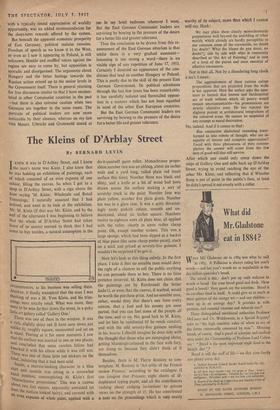The Kleins of D'Arblay Street
By BERNARD LEVIN
KNEW it was in D'Arblay Street, and I knew
the man's name was Klein. I also knew that he was holding an exhibition of paintings, each of which consisted of an even expanse of one colour, filling the canvas. So when I got to a shop in D'Arblay Street, with a sign above the door saying 'M. Klein : Wholesale and Retail Trimmings,' I naturally assumed that I had arrived, and went in to look at the exhibition. Mr. M. Klein (if that was Mr. Klein, and by the end of the afternoon I was beginning to believe that the whole of D'Arblay Street had taken leave of its senses) seemed to think that I had come to buy textiles, a natural assumption in the
circumstances, as his business was selling them. Anyway, it finally transpired that the man I was
inking of was a M. Yves Klein, and his trim- mings were strictly retail. What was more, they were to be seen farther down the street, in a poky little art gallery called 'Gallery One.'
There was one of them in the window. It was a rich, slightly shiny red (1 have seen nbses not unlike it), roughly square, unmounted and set on a stand. Peering at it for some moments I saw that the surface was marked in one or two places, and concluded that some careless fellow had knocked it with his elbow while it was still wet. label, was one of those little red stickers on the
label, indicating that it had been sold.
Inside, a morose-looking character in a blue shirt and sandals was sitting in a somewhat festal position, contemplating M. Klein's first `Monochrome proposition.' This was a canvas a ,bout two feet square, apparently untreated (at least the surface looked hairy), and covered with an even expanse of white paint, applied with a do-it-yourself paint roller. Monochrome propo- sition number two was an oblong, about six inches wide and a yard long, rolled plain red (matt surface this time). Number three was black and shiny, and a knife or a bit of wood had been drawn across the surface making a sort of scratchy track in the paint. Number four was plain yellow, number five plain green. Number ten was in a glass case. It was a quite devastat- ingly nasty pinkish colour, smooth and un- decorated, about six inches square. Numbers twelve to eighteen were all plain blue, all applied with the roller, clearly in some rather cheap paint. Oh, except number sixteen. This was a large sponge, which had been dipped in a bucket of blue paint (the same cheap poster-paint), stuck on a stick and priced at seventy-five guineas. 1 wouldn't be surprised if he gets it.
Now let's look at this thing calmly. In the first place, I take it that no sensible man would deny the right of a chancer to sell the public anything he can persuade them to buy. There is no false pretence involved; M. Klein does not claim that the paintings are by Rembrandt (he better hadn't), or even that the canvas, if washed, would be worth the purchase price. And no sensible man, either, would deny that there's one born every minute, that a fool and his money are soon parted, that you can fool some of the people all the time, and so on. No, good luck to M. Klein, and let him be comforted (if he needs comfort, and with the odd seventy-five guineas nestling in his bourse I should imagine he does not) with the thought that those who are rampaging about, getting Munnings-coloured in the face with fury, are doing so because they didn't think of it themselves.
Besides, there is M. Pierre Restany to con- template. M. Restany is 'Art critic of the French review Prismes,' according to the catalogue (I can imagine that Prismes; eight sheets of ill- duplicated typing paper, and all the contributors rushing about cadging invitations to private views on the strength of it). He has contributed a note on the proceedings which is very nearly
worthy of its subject, more than which I cannot well say. Hark
We may place these clearly monochromatic propositions well beyond the unfolding of other worlds; which already are hardly perceptible to our common sense of the reasonable, no doubt [no doubt? What the blazes do you mean, no doubt?], side by side with what is commonly described as 'the Art of Painting,' and in case of a level of the purest and most essential of affective resonances.
Nor is that all. Not by a thundering long chalk it isn't. I mean : The aggressiveness of these various colour propositions that are projected from the walls is but apparent. Here the author asks the spec- tator to furnish that intense and fundamental act of truth without which all poetry would remain uncommunicable—his presentations are strictly objective ones. He has rejected the slightest pretext at architectural integrations of the coloured areas. He cannot be suspected of any attempt at mural decoration.
No, indeed. And if it comes to that : Has omniscient dialectical reasoning trans- formed us into robots of thought, who are in- capable of sincere and complete appreciation? Faced with these phenomena of pure contem- plation the answer will come from the few men of good-will that still survive.
After which one could only creep down the steps of Gallery One and sidle back up D'Arblay Street, trying to avoid catching the eye of the other Mr. Klein, and reflecting that if Whistler flung a pot of paint in the public's face, at least he didn't spread it out evenly with a roller.














































 Previous page
Previous page